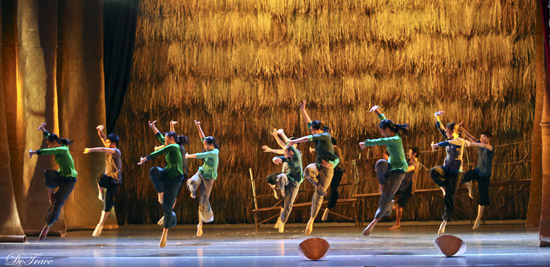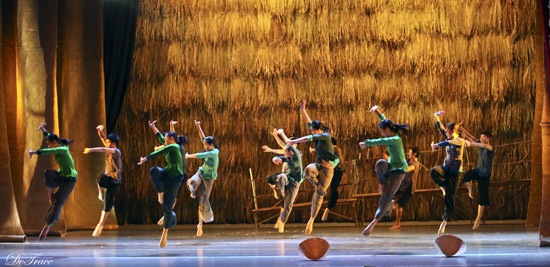(No.1, Vol.3, Jan-Feb 2013 Vietnam Heritage Magazine)
A bumper crop
Photo: Arabesque
Vietnam is a country of vivid colour, striking landscapes and intense human hurly-burly. Anyone who has visited her, however fleetingly, has left with a storehouse of her sights and sounds in his/her memory. The Vietnamese have a strong feeling for the arts and are proud to present their country’s soul in song, music, dance and drama. This was strongly evinced in a cultural show I had the pleasure to attend at the Saigon Opera House on the 14th of November , 2012. Entitled ‘Suong Som’ or ‘The Mist’, it featured all of the aforementioned delights, but especially contemporary dance and was performed by the company ‘Arabesque’. It does not attempt to cover the whole sweep of this varied land, concentrating only on scenes from daily life of the Mekong area.
I was urged to come half an hour before the scheduled start and the reason for this became apparent as I was met at the foyer by the show’s director and one of the choreographers, Mr Nguyen Tan Loc. There was an exhibition of everyday bamboo objects decorated with grains of rice. Mr Loc explained that rice was essential to his everyday existence. ‘Even when I am gone, it will feature in my funereal ceremony’, he said. It struck home to me just why the Mekong has the moniker of the ‘Rice Basket of Vietnam.’ All around, people were admiring the rice-adorned exhibits-fish traps, farming implements, a water jar, bamboo pole and baskets, water coconuts, a large screen for drying rice cakes, cooking pots, and a long chair/bed to name but a few. Theatre goers are actually provided with one artefact-namely ‘??a b?p’ which is a pair traditional hard bamboo sticks joined with string and used for stirring rice. ‘You can use them as percussion instruments,’ remarked Mr Loc, ‘there may be times when you may wish to join in the performance.’ We entered a darkened auditorium filled with the humming of chirping cicadas, the sound drawing us further into the atmosphere of a Mekong night.
Curtain rise coincided with the sounds of the delta dawn – a cock crowing, the burping of frogs and the braying of water buffalo. The opening scene called ‘On The Field’ reproduces a watery scene with mist rolling over a lady with a conical hat paddling her launch through water coconut scenery. Ao dai-clad maidens appear, and we see breakfast being bought from and served by a one-woman floating market. All very idyllic and evocative.
Two of the scenes touch on the delta religion. First, with the gong being the prominent musical accompaniment, come Buddhist monks clad in the most colourful of robes. They sway to the melodies and even at one point the choreography extends to one of them shaking vigorously as if having an epileptic fit. The second treats Christianity and is a night scene of girls and boys in file on two separate sides of the stage chanting Catholic hymns. A lot of bantering goes on, which I imagined to be flirting. My daughter who is a native Vietnamese speaker was able to explain to me that this was taking place at Easter time.
That terrible force of nature that can plague much of East Asia, the typhoon, is the subject of another scene. Whilst this does not occur very often in the Mekong Delta, it can happen. Indeed it did happen in the year I came to Vietnam; 1997. The very realistic simulation with dead bodies and building materials strewn across the stage in its aftermath brought back my memory of that terrible storm that took the lives of thousands and wreaked extensive damage.
There was one scene of which I personally was not particularly enamoured. It started off pleasantly enough with a group of young people in the fields beating bamboo poles on the ground. However it built up into a noisy crescendo with a lot of shouting from the actors. Then the audience was encouraged to add to the noise by making use of the clappers provided. Personal opinion of course, but I find it as annoying as vuvuzuelas at a World Cup football match. There is enough noise already in Vietnam I feel without bringing it into the opera house.
There is quite a lot of traditional music to be enjoyed in this show. I particularly loved the playing of the zither in the scene that celebrates silk production of Vietnam. With weavers at work at the foot of a long band of multi-coloured silk and a rickety bamboo bridge in the background, this was a particularly poignant moment in the show.
Do not leave this show early. The final scene, ‘Rice’, is a classic. The actors are spread on bamboo matting whilst rice rains down in a huge shower from above as they sift it through their hands. I recalled the words I once sang as a choirboy ‘All good things around us are sent from heaven above.’ This was a scene this writer is not going to forget for a good while.
One main feature of ‘The Mist’ is its original dance sequences. There is a mixture of modern dancing and Eastern classical ballet influences. The gyrating on the stage floor with sudden risings reminded me of a lighter take on Hip Hop. Mostly, however, there was a new variation on ballet. The dancers clearly knew the conventional ballet movements with quite a lot of gyrating and swirling but the choreographers had programmed more robotic movement and contortions of the body than is to be found in the more graceful traditional ballet.
If you are lucky to get tickets for ‘The Mist’ you are in for bean fest of colourful Mekong life. Everything about this show should please you. The music, the atmospheric stage lighting, the sets, and acting are all first class. In addition there is dance which you have never before seen and for you to make of what you will. You will be entertained for one and a quarter hour with never a dull moment and I am sure you will agree that you have been given good value for your money.
‘The Mist’ (Suong Som) was performed at the Saigon Opera House on November 14 and 15, 2012. Tickets were at VND600,000, VND450,000 and VND300,000 with a child/student price of VND150,000.
Contact: 094 7777 818.

